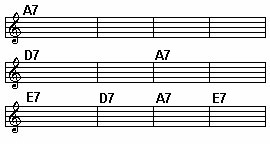Scroll through the lesson and click on notation/video/audio links to load the interactive players.
Please subscribe to get full access to all lessons for only $7.95/month PLUS 1 week free trial.

Riff Interactive lessons are
LESS expensive and
MORE interactive than alternatives!
More Info
|
|

Blues
Guitar For Beginners
Lesson
2 Lesson
Sample
Lyle:
Last lesson was a warm-up on playing the basic chords and rhythm for a "12 bar
blues in A".
Lyle: Now you'll learn some simple blues riffs
and then make them into a solo.
Lyle: Here's the chord progression and jam
track:
12 bar chord
progression

Jam Track - Blues in A
Lyle:
The A Minor pentatonic scale is a real great choice of scales to use when
improvising against a blues progression in
A:
Am
pentatonic
Lyle:
This scale is used the most for playing blues riffs. Learn to play it ascending
and descending.
Lyle: The next several blues riffs all have a few
things in common. They all have a note that has a slight bend to it, and they
all have a strong vibrato on a certain note. Here's your first
riff:
blues riff
1
radica: I'm
finally at least getting some of that nice vibrato of yours. Thanks again for
that helpful video from last session
Lyle: Such a simple blues riff, yet very
effective because of the slight bend and then vibrato. Watch the video clip of
these techniques:
blues riff 1
Lyle:
Any questions?
ZZ: I notice you bent it down, does it give a different
sound then a up bend?
Lyle: No, same sound, but it's easier to pull
/bend the string down. Gravity is a good tool when you're able to use
it.Lyle: You can try playing this riff over and over
against the looping jam track so you can hear how well it
works.
tommy: Do
we play just the Am pent scale, do we switch during the changes of the jam
track?
Lyle:
Good question tommy. You can play the A Minor pentatonic scale over the whole
jam track, no matter what chord is being played.
Jim: But
you COULD change right?
Lyle: Yes, you could change to many different
scales. I can think of about 20 different ones you could play against the jam
track. But that's not where we are going in this lesson. This is level 1 for
beginners, so they can learn to jam and play the blues!
Lyle: The next riff is just a variation of the
first riff:
blues
riff 2
blues riff
2
Lyle:
The next riff is yet another variation. This riff will resolve on the root note,
A.
blues riff
3
blues riff
3
Lyle:
Notice all three riffs have the same slight bend and
vibrato.
Lyle: Here's the next variation.
blues riff
4
blues riff
4
Jim: When you
are playing the scale, how do you know which notes you can and can not bend?
Only bend to other notes in the scale?
Lyle: That is a good rule.
Lyle: But in these riff you are bending the 5th
fret, 3rd string only a 1/4 step, not even a full note worth. Something unique
to the blues sound.
Lyle: Here's the next
riff:
blues riff
5
michael:
Practice bending them all.. the notes themselves will tell you "bend me"...
sounds funny but true
blues riff 5
Lyle:
I'll dig deeper into bending notes later. Remember this lesson is for beginners
and sometimes bending strings is hard to do for the new guitarists. These slight
bends is just enough to get you a cool blues sound.
Lyle: Here's the last
riff:
blues riff
6
blues riff
6
Lyle:
Now you should review all 6 riffs:
6 riff review
6 riff
review
Lyle: You're about to learn a complete solo made
from just these 6 simple blues riffs.
Paul:
Is there
a CD that has the scales to work on, such as this Am pentatonic?
Support: Paul, pretty much all of our CDs will
contain scales to work on, just in the context of the topic (jazz, blues, SRV,
BB King, etc)
Lyle: Ok, here's your solo made from these riffs,
played against the Jam Track in A.
solo
solo
michael: You
bend the C since that is the note that gets dropped a half tone in making the A
major to minor pent scale. By bending it 1/4 your staying in the middle of what
sounds natural / good to the ear. Is that close?
Lyle:
michael, by bending the note up slightly it seems to tease the ear into thinking
the note is going to resolve to the major third, which will fit the dominant A7
chord better. It's mostly just to tease the ear.
Lyle: I'm trying to teach just the little basics
and a few cool riffs. I don't want to overload the typical beginner. Sometimes
it's better to learn to play something, then learn the how and why later. Get
hooked on the guitar then learn what and why you're playing what you're playing.
If that makes sense.
radica:
good advice.
Razor: Make good sense - great
Lyle: In the next lesson you'll learn another
blues jam in a new key.
Lyle: Well that's all for this lesson. Thanks for
being here tonight, you've been a good group. See you at the next jam!
|
<< load notation from left
|
|
<< load audio from left
|
<< load audio from left
|